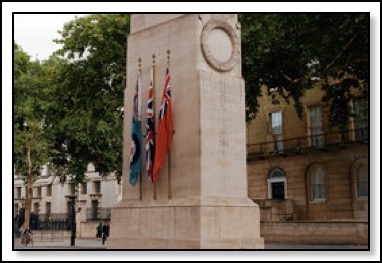The Cenotaph
14/11/13 09:42 Filed in: History
One example of the simplicity and power of a war memorial is described in the article about the Cenotaph. A description of how the Cenotaph came to be follows.........
“With the signing of the peace treaty at Versailles in 1919, the War Cabinet, led by Prime Minister David Lloyd George, planned Peace Day. This was to be a festive celebration of the end of the carnage. The government Office of Works, under the direction of Alfred Mond, asked Edwin Lutyens to design a temporary memorial to be erected in Whitehall, along the route of a massive victory parade of the allied troops through central London. Lutyens, who had made his mark designing handsome country homes, was the architect of the new capitol of the British Raj in New Delhi, a commission that had catapulted him to international fame.
Just two weeks after hearing from Mond, Lutyens had a plan in hand, one deeply rooted in the classical past, not only in form but in function. The monument was to be a cenotaph, a structure incorporating an empty tomb, often built to memorialize a missing warrior. Constructed of wood and plaster, Lutyens's four-sided composition, which ascended through a series of subtle setbacks toward a summit capped by a sarcophagus, was ready for the Peace Day victory parade of July 19, 1919.”

“With the signing of the peace treaty at Versailles in 1919, the War Cabinet, led by Prime Minister David Lloyd George, planned Peace Day. This was to be a festive celebration of the end of the carnage. The government Office of Works, under the direction of Alfred Mond, asked Edwin Lutyens to design a temporary memorial to be erected in Whitehall, along the route of a massive victory parade of the allied troops through central London. Lutyens, who had made his mark designing handsome country homes, was the architect of the new capitol of the British Raj in New Delhi, a commission that had catapulted him to international fame.
Just two weeks after hearing from Mond, Lutyens had a plan in hand, one deeply rooted in the classical past, not only in form but in function. The monument was to be a cenotaph, a structure incorporating an empty tomb, often built to memorialize a missing warrior. Constructed of wood and plaster, Lutyens's four-sided composition, which ascended through a series of subtle setbacks toward a summit capped by a sarcophagus, was ready for the Peace Day victory parade of July 19, 1919.”

blog comments powered by Disqus

